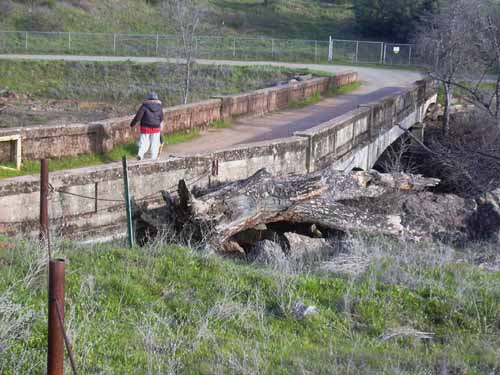|
Spenceville Wildlife Area
Sponsored by the Placer Pacers, the Spenceville Wildlife Area walk went through wooded grassland and culminated with a climb to view Fairy Falls(also known as Shingle Falls and Dry Creek Falls). First we crossed old concrete bridges over Little Dry Creek to get to the start point. Then the walk continued on dirt roads and trails, through open grasslands and wooded areas of blue oak and gray pine. Cows, and cow pies, were companions along much of the route. One last climb brought you up to an overlook point that looked down on the 60' drop of Fairy Falls. At the overlook point, you can see the remains of an illegal dredging operation in the 1960's. A trespass gold miner set up a drag line and pulled 50-60' of gravel out of the pool at the bottom of the falls. There was a steel boom on a tractor with a winch and buckets. The gravel was brought up and run through a sluice box, but the operation ended when it was found the original owners still had mineral rights. Spenceville was established 1862 after the discovery of copper ore at the site. It was considered one of the most long-lived copper mines, although it exploited relatively low grade ore. At one time the town of Spenceville had over 60 families, with a school, store and hotel. Opened in 1863, the mine operated as the Well Lode Copper Mine from 1863 through 1865 and closed shortly after the Civil War ended. After it was bought and upgrades made, it became the San Francisco Copper Mine and Reduction Works. In August of 1880, a headframe toppled into a vertical shaft. No fatalities occurred but the cost of clearing the shaft was extensive; in December of that year preparation began to operate as an open cut. Eight years later the mine closed. From 1888 through 1897 the Imperial Paint Company and Copper Works leached the tailings for copper cement and also used them as a pigment in the manufacture of Spenceville Red/Venetian Red paint. The paint,enormously popular to begin with (Gold Medal in SF 1894 Winter Exposition) ended in infamy sometime around 1896/97 when it was discovered that the paint corroded structural nails and barns were beginning to collapse. In 1897 the Spence Mineral Company purchased the mine proper to manufacture sulfuric acid. Between 1915 and 1917 a fire razed the mine properties and all work there ceased for good. The town of Spenceville, east of the mine site, continued to survive on agriculture up to 1941, when the military acquired the property and used the site as a training ground. The town was made into a mock German town where Army recruits trained in preparation for combat duty in Europe. The area includes tank traps and concrete machinegun bunkers, some of which can still be seen. In 1962 the land was split off Beale Air Force Base and deeded to the state to be used as a wildlife preserve and recreation area. Besides the large mine tailing pile, traces of the town may be spotted if you look hard, but as inferred, there is no Starbucks here. The Spenceville Mine site and old town of Spenceville are within the Spenceville Wildlife Refuge boundaries.
Back Photo page
|
